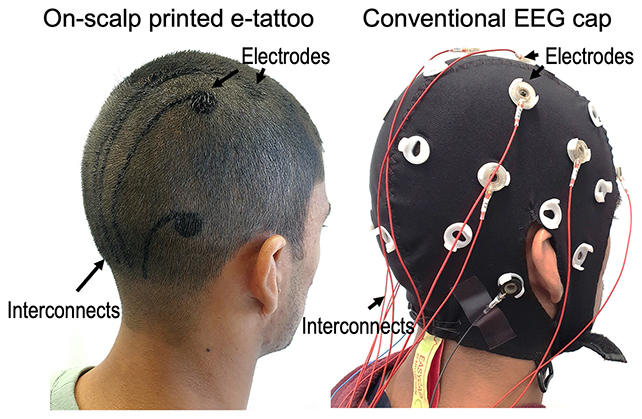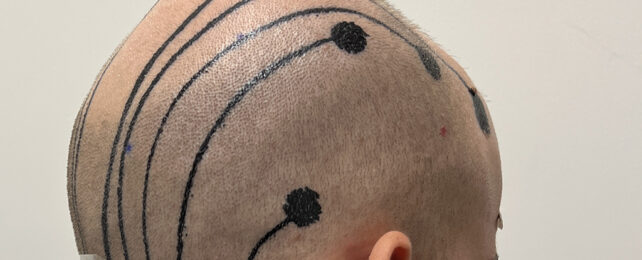Non-invasive brain imaging is usually handled with electrodes, sticky gels, and wires: it's an ugly, uncomfortable, and time-consuming setup. But scientists have now developed a potential upgrade in the form of temporary electronic tattoos.
These e-tattoos work through liquid ink printed on the scalp. In a new study, they were shown to be as accurate as conventional electroencephalography (EEG) methods, while being much easier to configure. Even better, they can work through hair (as long as it's short hair).
According to the researchers who developed the ink, from the The University of Texas at Austin and the University of California, Los Angeles (UCLA), this new technique promises advances in patient monitoring and disease diagnosis.

"Our innovations in sensor design, biocompatible ink, and high-speed printing pave the way for future on-body manufacturing of electronic tattoo sensors, with broad applications both within and beyond clinical settings," says electrical engineer Nanshu Lu from the University of Texas at Austin.
The researchers say their new approach is more comfortable for the subject, lasts longer without any signal degradation, and is more precise in the data it collects. Made of conductive polymers, the e-tattoos are sprayed directly onto the head using a custom inkjet printer.
Having previously been used to measure muscle fatigue and heart rate, these e-tattoos have now been shown to work for brain activity too, with specially designed algorithms able to figure out where on the scalp they should be placed.
Further innovations came in the application of the e-ink to replace part of the wiring in a standard EEG. The researchers were able to use shorter conventional wires to transmit the collected data back to a recording device.
"This tweak allowed the printed wires to conduct signals without picking up new signals along the way," says materials scientist Ximin He from UCLA.
As always, there's more work to do. Next, the team behind the e-tattoo wants to develop a way of embedding wireless transmission capabilities into the printed e-ink patches, as well as getting their tech working with a broader range of hairstyles and hair types.
Eventually, the e-tattoos could also be used as the basis of brain-computer interfaces (BCIs), say the researchers – not just reading brain activity but trying to interpret it and use it to trigger actions.
As with EEGs, the current setups for BCIs are bulky and difficult to manage. If the current tech could be replaced with something based on e-tattoos, it could potentially become accessible to a much wider group of people.
"Our study can potentially revolutionize the way non-invasive brain-computer interface devices are designed," says neuroengineer José Millán from the University of Texas at Austin.
The research has been published in Cell Biomaterials.
